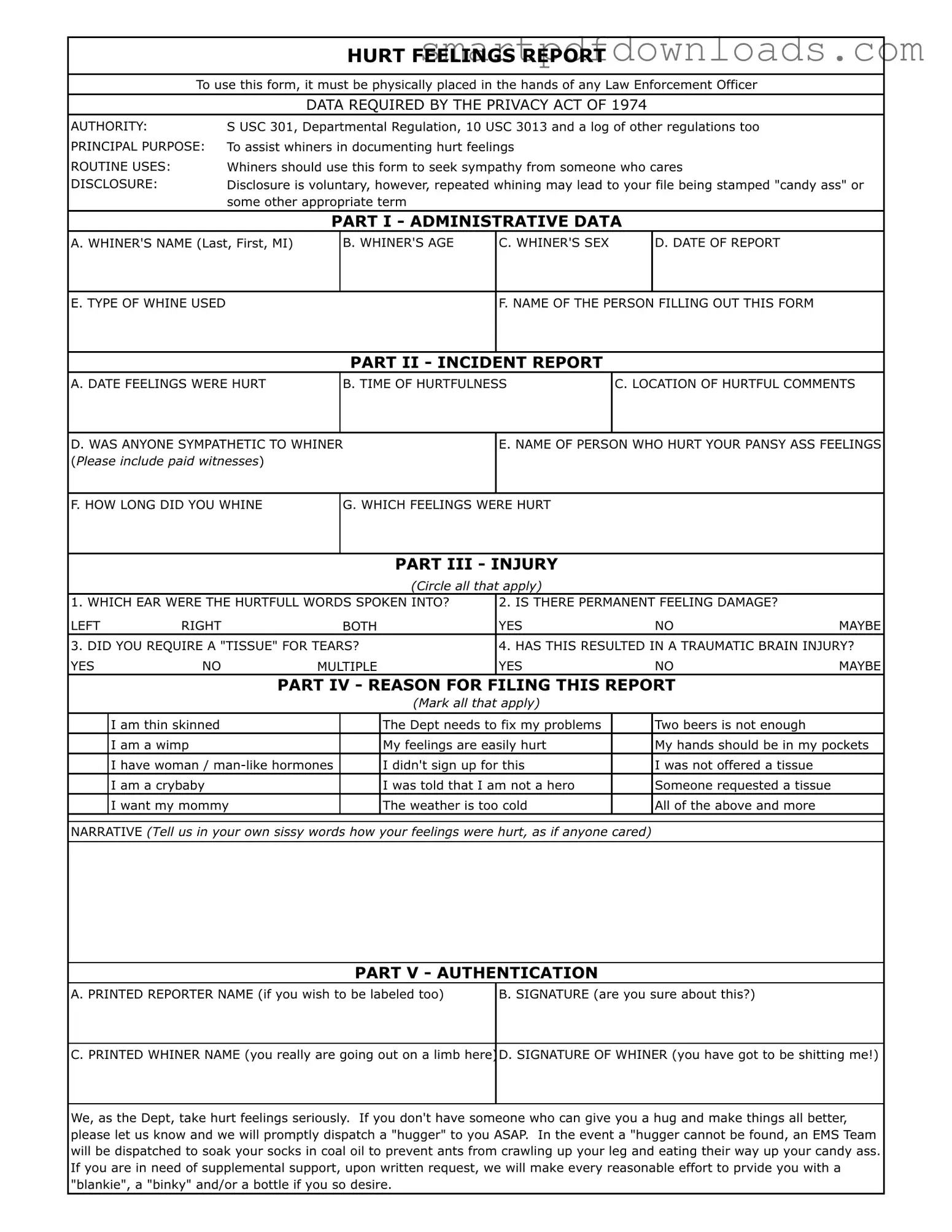HURT FEELINGS REPORT
To use this form, it must be physically placed in the hands of any Law Enforcement Officer
DATA REQUIRED BY THE PRIVACY ACT OF 1974
AUTHORITY: PRINCIPAL PURPOSE:
ROUTINE USES:
DISCLOSURE:
S USC 301, Departmental Regulation, 10 USC 3013 and a log of other regulations too To assist whiners in documenting hurt feelings
Whiners should use this form to seek sympathy from someone who cares
Disclosure is voluntary, however, repeated whining may lead to your file being stamped "candy ass" or some other appropriate term
PART I - ADMINISTRATIVE DATA
A. WHINER'S NAME (Last, First, MI)
F. NAME OF THE PERSON FILLING OUT THIS FORM
PART II - INCIDENT REPORT
A. DATE FEELINGS WERE HURT
C. LOCATION OF HURTFUL COMMENTS
D. WAS ANYONE SYMPATHETIC TO WHINER (Please include paid witnesses)
E. NAME OF PERSON WHO HURT YOUR PANSY ASS FEELINGS
F. HOW LONG DID YOU WHINE
G. WHICH FEELINGS WERE HURT
PART III - INJURY
(Circle all that apply)
|
|
|
|
|
|
|
|
|
1. WHICH EAR WERE THE HURTFULL WORDS SPOKEN INTO? |
2. IS THERE PERMANENT FEELING DAMAGE? |
|
LEFT |
RIGHT |
|
BOTH |
|
YES |
NO |
MAYBE |
3. DID YOU REQUIRE A "TISSUE" FOR TEARS? |
|
4. HAS THIS RESULTED IN A TRAUMATIC BRAIN INJURY? |
YES |
NO |
MULTIPLE |
|
YES |
NO |
MAYBE |
|
|
PART IV - REASON FOR |
FILING THIS REPORT |
|
|
|
|
|
(Mark all that apply) |
|
|
|
I am thin skinned |
|
|
The Dept needs to fix my problems |
|
Two beers is not enough |
|
|
I am a wimp |
|
|
My feelings are easily hurt |
|
My hands should be in my pockets |
|
I have woman / man-like hormones |
|
I didn't sign up for this |
|
I was not offered a tissue |
|
|
I am a crybaby |
|
|
I was told that I am not a hero |
|
Someone requested a tissue |
|
|
I want my mommy |
|
|
The weather is too cold |
|
All of the above and more |
|
NARRATIVE (Tell us in your own sissy words how your feelings were hurt, as if anyone cared)
PART V - AUTHENTICATION
A. PRINTED REPORTER NAME (if you wish to be labeled too)
B. SIGNATURE (are you sure about this?)
C. PRINTED WHINER NAME (you really are going out on a limb here) D. SIGNATURE OF WHINER (you have got to be shitting me!)
We, as the Dept, take hurt feelings seriously. If you don't have someone who can give you a hug and make things all better, please let us know and we will promptly dispatch a "hugger" to you ASAP. In the event a "hugger cannot be found, an EMS Team will be dispatched to soak your socks in coal oil to prevent ants from crawling up your leg and eating their way up your candy ass. If you are in need of supplemental support, upon written request, we will make every reasonable effort to prvide you with a "blankie", a "binky" and/or a bottle if you so desire.

